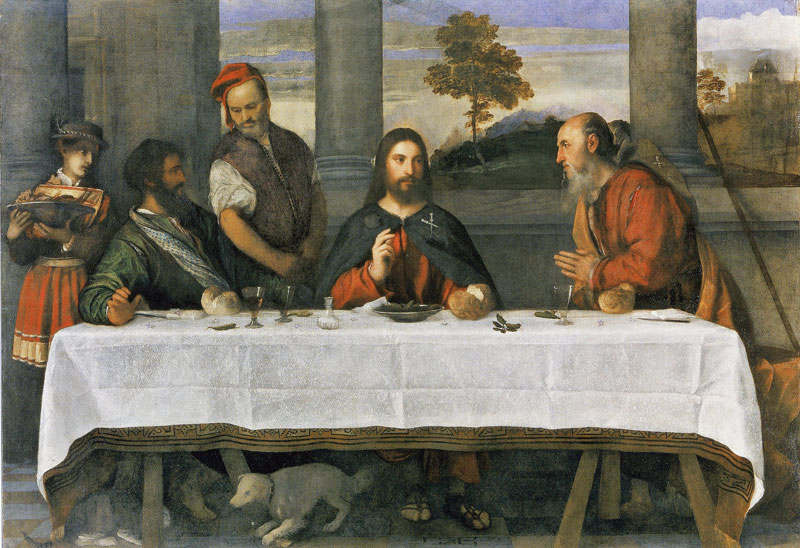The Supper at Emmaus (Q3937710)
Label from: English (en)
movement:
Venetian school (Q610687)
genre:
religious art (Q2864737)
artist:
Titian (Q47551)
collection:
no value
Walker Art Gallery (Q1536471)
location:
Walker Art Gallery (Q1536471)
main subject:
Supper at Emmaus (Q16519437)
based on:
Pilgrims at Emmaus (Q11091772)
depicts:
Jesus (Q302)
Supper at Emmaus (Q16519437)
instance of:
painting (Q3305213)
catalog URL: https://www.liverpoolmuseums.org.uk/artifact/supper-emmaus
information from the Walker Art Gallery catalog
description: At first glance this painting provides an evocative and straightforward a depiction of a Bible story, the 'Supper at Emmaus', related by St. Luke in his gospel (Luke,chapter 24, verses 13-32), and painted by one of Europe’s greatest artists of the 16th century cultural Renaissance, Titian. The supper, held in an inn at the village of Emmaus, near Jerusalem, was one of the occasions when Jesus revealed himself to his followers after his Crucifixion and Resurrection. One of the two disciples was called Cleophas the other is unnamed, but because the story is only told in Luke’s gospel, he is traditionally identified as St. Luke, despite the fact that Luke lived many decades after Christ’s Crucifixion. When the disciples first met Christ, on the way to Emmaus, they failed to recognise him and mistook him for a pilgrim, like themselves. This is why Titian has shown the central figure of Christ, wearing on his right shoulder, the most common symbol of pilgrimage, the scallop-shell, worn by travellers to the Spanish shrine of St James at Santiago de Compostella. Once at Emmaus they pressed the stranger to take supper with them. Titian superbly captures the evening sunlight filtering across the background landscape. It is only when Christ blessed and broke the bread, as he had done at the Last Supper before his Crucifixion, that they recognised him. Of the two disciples the figure on the left who starts back open-mouthed in amazement as he recognises Christ’s identity has been presumed to be Luke and the praying man on the left, the virtually unknown figure of Cleophas. But early religious commentators on the Bible, such as the 5th century bishop St. Augustine, describe Cleophas reacting to the revelation by praying out loud and St Luke by meditating, and later becoming a pilgrim. So the open mouthed figure may equally represent Cleophas and the contemplative figure whose pilgrim’s staff leans nearby, and to whom Christ directs his glance as he blesses the bread, the future author of the Gospel of St. Luke.In Venice this subject was usually treated as an excuse to paint a lavish banquet with splendid table settings. Here the simple wine glasses, bread-rolls and chicken (brought in by the servant-boy) are unusually accompanied by broad-bean pods and delicate little bright-blue borage flowers scattered across the table. The broad bean was considered peasant food, typically served to poor pilgrims on their travels. But this curious combination may also reflect a Venetian custom of eating candied broad beans (fave dolci)at the Feast of the Dead on All Souls Day, 2November. Broad beans were thought to possess the soul of the dead and borage, which was used to freshen wine, was believed to drive away sadness and bring joy. The bread and wine relate to the Eucharist, the key Christian ceremony. The dog features in other earlier Venetian depictions of the scene. It probably refers to Christ’s words to the Canaanite woman (Matthew 15, 21-28) who begged him to exorcise a demon from her daughter. Initially Christ refused saying ‘it is not fair to take the children’s bread and throw it to the dogs’. But she persuaded him by retorting ‘Yes, Lord, yet even the dogs eat the crumbs that fall from their master’s table’. The cat may have been added (perhaps by a workshop assistant) as an amusing incident, unusual in Titian’s religious paintings, which tend to be solemn and devotional. Close to the dog’s back legs and painted as if carved into floor tiles near Christ’s feet is TITIANUS. F, the Latin for ‘Titian made this’. The form that this signature takes gives a clue as to when the picture was painted. Until about 1533 Titian seems to have signed himself with a ‘C’ instead of a ‘T’ in the middle of his first name.
This tool must be connected with Wikidata to work.
